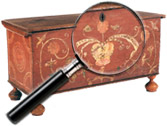|
|
Weller Pottery ‘Flemish’
Flemish is another of Rudolph Lorber’s creations for Weller Pottery. Raised hand colored designs and the familiar polychrome brown and green pastels characterize many of the Flemish wares made during the 1920s. Flemish reed basket planters were introduced in 1925, squirrel bowls around 1928.
Weller Pottery ‘Denton’
Denton (also called Dunton) was produced in either a black or white gloss glaze and was forerunner to Weller’s Rosemont line.
Weller Pottery ‘Brighton’
Bright colors and deep glaze characterizes Weller’s Brighton. Little is known of the design origin, although many Brighton bird figurines were sold to lamp companies and used to decorate table and floor lamps. Weller’s Malta line was produced at the same time and offered many of the same Brighton figures in an undecorated matt finish.
Weller Pottery ‘Baldwin’
Large red apples molded in relief on a Flemish brownish green or navy blue ground characterize Baldwin.
Weller Pottery Pop-eye Dog
Pop-eye dogs were also made in larger 8.5″ and 9.5″ sizes and were originally sold as part of Weller’s garden ware series.
Weller Pottery
Significance of Weller Pottery: Utilitarian potter Samuel A. Weller (1851 to 1925) abandoned painted flowerpots and sewer tile for art pottery in 1894. That year he formed a short-lived pottery partnership with fellow potter William A. Long. Their company’s major product was Lonhuda, a type of art pottery that Long developed to mimic Rookwood’s standard glaze. Lonhuda’s backgrounds were air brushed and its designs hand-painted with underglaze slip, techniques successfully pioneered by [...] Click here to continue reading.
Jose Weiss (French, 1859 to 1919)
Jose Weiss was a French artist who moved to England in 1893. He exhibited at the Royal Academy and the Paris Salon. He was a landscape painter who was influenced by the Barbizon school and frequently painted scenes from the Sussex area.
Information courtesy of Cowan’s Auctions Inc.
John Ellsworth Weis (1892-1962)
John Weis, born in Indiana, was a well-known Cincinnati painter who worked in a variety of styles. He served his country in WWI and studied in Paris. He studied under Frank Duveneck, Lewis Henry Meakin, Herman Wessel and other prominent artists at the Cincinnati Art Academy. Weis himself subsequently taught at the Academy for more than 30 years. He passed away in 1962 after a fall in his home.
Information [...] Click here to continue reading.
Robert Walter Weir (1803-1889)
Born in New York City in 1803, Robert Walter Weir studied under John Wesley Jarvis and the English artist Robert Cox. In 1824 he traveled to Italy and studied in Florence for three years. Upon his return to the United States, Weir set up a studio in New York and executed portraiture, genre paintings and Hudson River landscapes. In 1829 he was elected an Academician at the National Academy.
Weir [...] Click here to continue reading.
Adolph Alexander Weinman (German, American, 1870 to 1952)
Adolph Alexander Weinman emigrated from Germany to the United States as a child. He studied in New York at Cooper Union and the Art Students League and under sculptors Augustus Saint-Gaudens and Philip Martiny. He later assisted Charles Niehaus, Olin Warner and Daniel Chester French. Both an architectural sculptor and a medalist, he is celebrated as the designer of the “Walking Liberty” fifty-cent piece and the [...] Click here to continue reading.
|
Recent Articles
- Charles Alfred Meurer – American Artist & Tromp L’Oeil Artist
- Sendak, Maurice – American Artist & Writer
- Godie, Lee – American Artist
- Davis, Vestie – American Artist
- Bartlett, Morton – American Artist
- Mackintosh, Dwight – American Artist
- Evans, Minnie Jones – African-American Artist
- Mumma, Ed (Mr. Eddy) – American Artist
- Nice, Don – American Artist
- Savitsky, John (Jack) – American Artist
- Gordon, Harold Theodore (Ted) – American Artist
- Dial, Thornton – African-American Artist
- Doyle Sam – American Artist
- Johnson, Lester Frederick – American Artist
- Finster, Howard – American Artist
|
|
